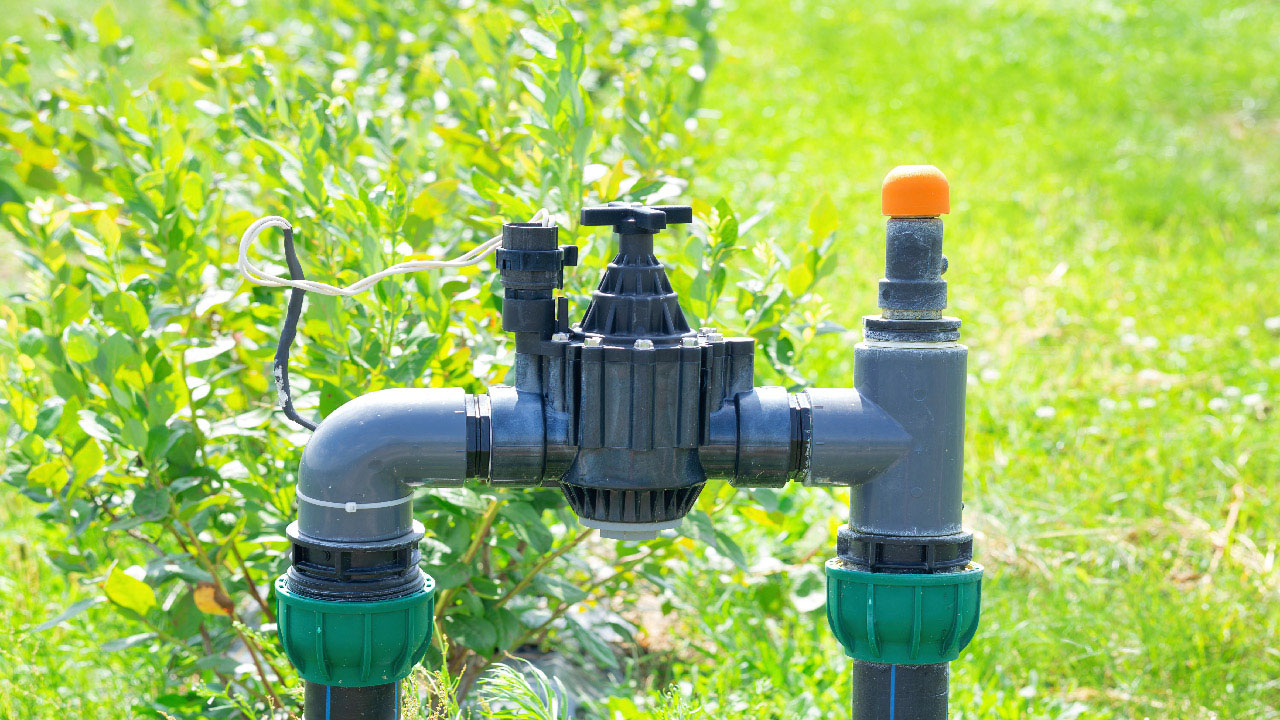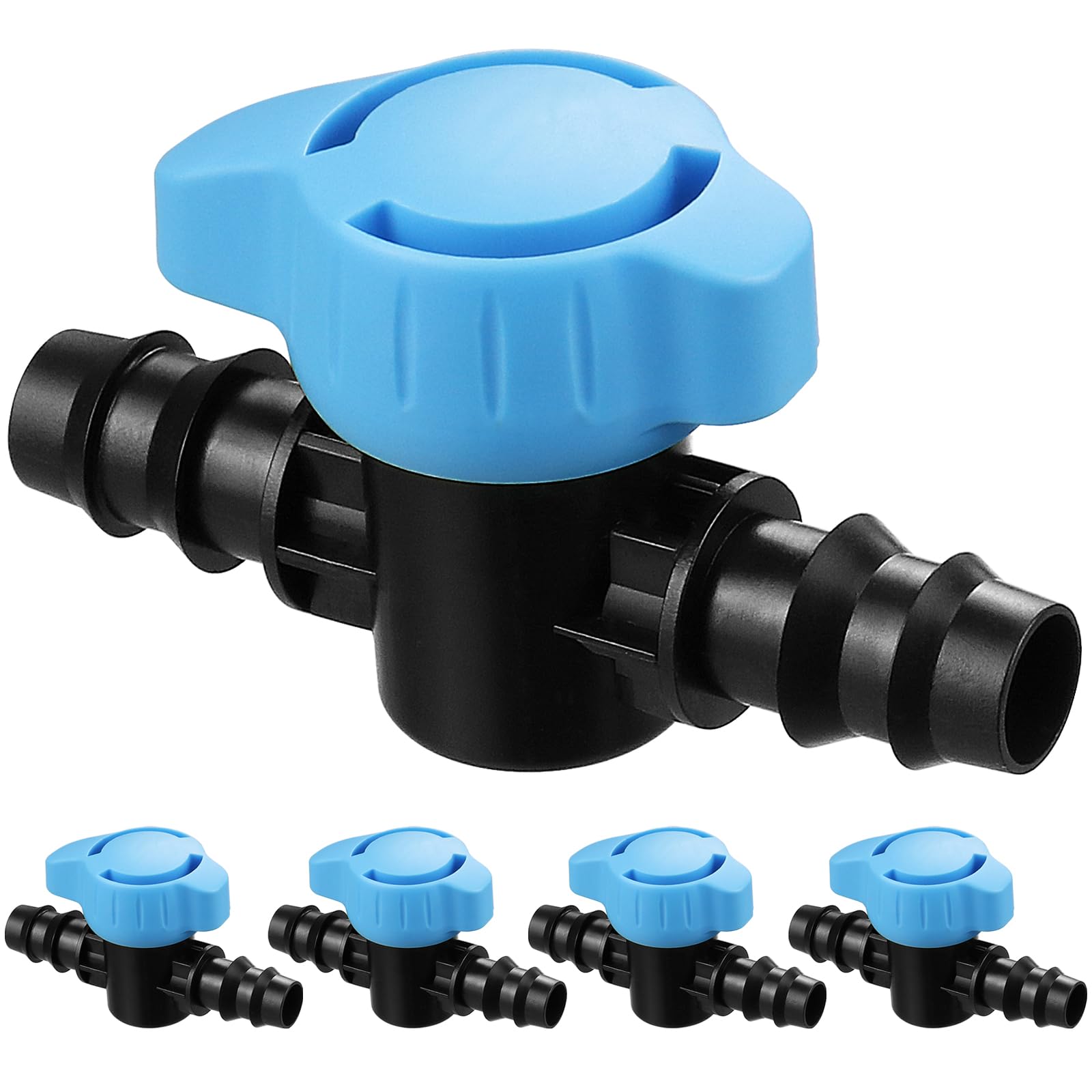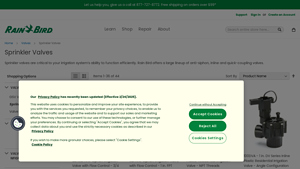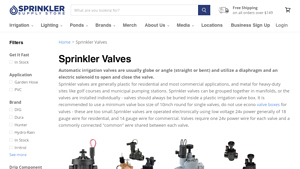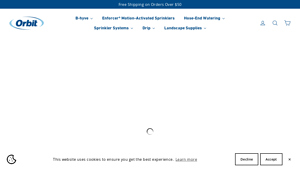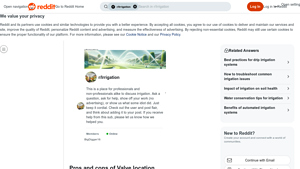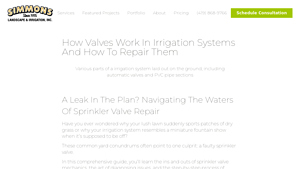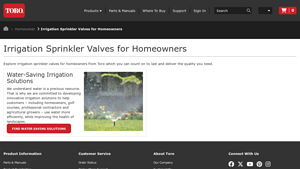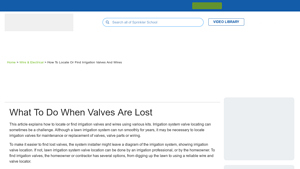Introduction: Navigating the Global Market for irrigation system valve
In today’s rapidly evolving agricultural landscape, sourcing effective irrigation system valves is crucial for enhancing water efficiency and crop yield. With diverse global markets presenting unique challenges, international B2B buyers often grapple with selecting the right valves that meet their specific operational needs. This guide serves as an essential resource, addressing a variety of valve types—including anti-siphon, inline, and quick-coupling options—while exploring their applications across different sectors such as residential, commercial, and industrial irrigation systems.
As you navigate the complexities of purchasing irrigation system valves, this comprehensive guide will empower you to make informed decisions. We delve into critical aspects such as supplier vetting processes, cost considerations, and the importance of material choice—plastic versus metal—tailored to the demands of your local environment, whether you’re operating in Brazil’s diverse climates or the arid landscapes of Saudi Arabia.
By arming yourself with this knowledge, you’ll be better equipped to optimize your irrigation systems for maximum efficiency and sustainability. The insights provided here will not only streamline your procurement process but also enhance your understanding of the essential components that contribute to effective irrigation management, ultimately leading to improved agricultural productivity and resource conservation.
Understanding irrigation system valve Types and Variations
| Type Name | Key Distinguishing Features | Primary B2B Applications | Brief Pros & Cons for Buyers |
|---|---|---|---|
| Anti-Siphon Valve | Prevents backflow; typically has a built-in vacuum breaker | Residential and light commercial systems | Pros: Protects water supply, easy to install. Cons: May require regular maintenance. |
| Inline Valve | Installed directly in the irrigation line; can be globe or angle | Commercial irrigation, golf courses | Pros: Efficient flow control, compact design. Cons: Limited accessibility for repairs. |
| Quick Coupling Valve | Allows for rapid connection/disconnection of hoses or lines | Temporary irrigation setups, landscaping | Pros: Flexible use, easy to operate. Cons: Can be less durable under heavy use. |
| Pressure-Regulating Valve | Maintains consistent pressure; prevents overwatering | Agricultural and large-scale irrigation | Pros: Water conservation, consistent performance. Cons: Higher initial cost. |
| Solenoid-Operated Valve | Uses electric solenoids for automated control | Automated irrigation systems | Pros: Precision control, integration with smart systems. Cons: Requires electrical setup and maintenance. |
What Are the Characteristics of Anti-Siphon Valves?
Anti-siphon valves are designed to prevent the backflow of contaminated water into the main supply. This is crucial in areas where water quality is paramount, such as residential gardens and light commercial properties. They typically feature a built-in vacuum breaker, making them easy to install. B2B buyers should consider the local regulations regarding backflow prevention, as these valves are often mandated by law. Regular maintenance is necessary to ensure optimal performance, as debris can affect their functionality.
How Do Inline Valves Function in Irrigation Systems?
Inline valves are integrated directly into the irrigation piping system, offering a streamlined solution for flow control. They can be configured as either globe or angle valves, making them versatile for various applications, particularly in commercial settings like golf courses and parks. When purchasing inline valves, B2B buyers should focus on the material (plastic vs. metal) based on the expected operational pressures and environmental conditions. Accessibility for maintenance is also a consideration, as these valves may be buried or installed in hard-to-reach areas.
What Makes Quick Coupling Valves Ideal for Temporary Setups?
Quick coupling valves are designed for ease of use, allowing for rapid connection and disconnection of hoses or irrigation lines. This feature is particularly beneficial for temporary irrigation setups in landscaping projects or during special events. B2B buyers should weigh the benefits of flexibility against the potential for reduced durability under heavy usage. Selecting high-quality materials can enhance longevity, making these valves a viable option for both short-term and seasonal applications.
Why Are Pressure-Regulating Valves Important for Water Conservation?
Pressure-regulating valves play a critical role in maintaining a consistent water pressure within irrigation systems, thus preventing overwatering and promoting efficient water usage. They are particularly valuable in agricultural settings where water conservation is a priority. B2B buyers should consider the initial investment against long-term savings in water costs and improved crop yields. The selection of the right pressure-regulating valve should also account for the specific pressure requirements of the irrigation system.
How Do Solenoid-Operated Valves Enhance Irrigation Automation?
Solenoid-operated valves utilize electric solenoids to enable automated control of irrigation systems. This automation allows for precise scheduling and integration with smart irrigation technologies, making them ideal for commercial and agricultural applications. Buyers should evaluate the electrical requirements and compatibility with existing systems when considering these valves. While they offer significant operational advantages, the necessity for electrical maintenance and potential troubleshooting should also be factored into purchasing decisions.
Key Industrial Applications of irrigation system valve
| Industry/Sector | Specific Application of Irrigation System Valve | Value/Benefit for the Business | Key Sourcing Considerations for this Application |
|---|---|---|---|
| Agriculture | Automated irrigation systems for crop production | Increases yield and reduces water waste | Durability, compatibility with existing systems, and maintenance support |
| Landscaping | Sprinkler systems for commercial and residential landscaping | Enhances aesthetic value and ensures plant health | Valve size, material choice, and ease of installation |
| Golf Course Management | Precision irrigation systems for turf management | Maintains optimal playing conditions and reduces costs | High-performance valves, resistance to corrosion, and reliability |
| Municipal Water Systems | Water distribution systems in urban areas | Ensures efficient water supply and conservation | Compliance with local regulations and pressure ratings |
| Horticulture | Drip irrigation systems for nurseries and greenhouses | Optimizes water usage and supports plant growth | Customization options and scalability for future needs |
How Are Irrigation System Valves Used in Agriculture?
In agriculture, irrigation system valves are essential for managing water flow in automated irrigation systems. These valves help regulate water distribution to crops, enhancing yield while minimizing waste. For international buyers, especially from regions like Africa and South America, selecting durable and reliable valves that can withstand varying climatic conditions is crucial. Additionally, compatibility with existing irrigation infrastructure and ease of maintenance are key considerations to ensure operational efficiency.
What Role Do Irrigation System Valves Play in Landscaping?
In landscaping, irrigation system valves facilitate the efficient watering of commercial and residential areas. These valves are integral to sprinkler systems, ensuring that water is evenly distributed to maintain the aesthetic appeal and health of plants. For buyers in Europe and the Middle East, factors such as valve size, material durability, and ease of installation are paramount. Investing in high-quality valves can lead to long-term savings by reducing water consumption and maintenance costs.
Why Are Irrigation System Valves Important for Golf Course Management?
Golf course management relies heavily on precision irrigation systems that utilize high-performance irrigation valves. These valves ensure that turf is maintained at optimal moisture levels, which is vital for both playability and aesthetic appeal. Buyers from regions with extreme weather conditions, such as Saudi Arabia, should prioritize valves that resist corrosion and provide reliable performance under pressure. Additionally, sourcing valves that are easy to operate and maintain can lead to significant cost savings in water management.
How Do Municipal Water Systems Utilize Irrigation System Valves?
Municipal water systems employ irrigation valves to manage water distribution efficiently across urban areas. These valves play a critical role in ensuring that water supply is consistent and sustainable, which is especially important in water-scarce regions. B2B buyers in the Middle East and Africa must consider compliance with local regulations and the valves’ pressure ratings to guarantee safety and reliability. Investing in robust valve systems can significantly enhance water conservation efforts and operational efficiency.
How Are Irrigation System Valves Used in Horticulture?
In horticulture, irrigation system valves are crucial for controlling water flow in drip irrigation setups used in nurseries and greenhouses. These valves optimize water usage, allowing for precise watering that supports healthy plant growth. International buyers should focus on customization options to meet specific horticultural needs, as well as scalability for future expansions. The right valves can lead to improved crop quality and reduced operational costs, making them a valuable investment in horticultural operations.
3 Common User Pain Points for ‘irrigation system valve’ & Their Solutions
Scenario 1: Difficulty in Sourcing Durable Valves for Harsh Conditions
The Problem: B2B buyers operating in regions with extreme climates, such as the deserts of the Middle East or the tropical areas of South America, often face significant challenges in sourcing irrigation system valves that can withstand harsh environmental conditions. These valves are frequently exposed to high temperatures, dust, and corrosive elements, leading to premature failure. Buyers are concerned about the long-term reliability and maintenance costs associated with frequent replacements, which can disrupt irrigation schedules and increase operational expenses.
The Solution: To address this issue, buyers should prioritize sourcing valves made from high-quality materials such as brass or UV-resistant plastics designed for durability. It’s essential to evaluate suppliers based on their product specifications and performance in extreme conditions. For instance, inquire about valves that feature corrosion-resistant coatings or those specifically engineered for anti-siphon applications to prevent backflow, which is critical in areas with fluctuating water levels. Engaging with manufacturers who provide robust warranties and support can also ensure that you are investing in a product that will withstand the test of time. Conducting thorough market research and utilizing local distributors familiar with regional needs can further enhance the procurement process.
Scenario 2: Inefficient Water Management Leading to Increased Costs
The Problem: Many B2B buyers, especially those managing large agricultural operations, struggle with inefficient water management due to inadequate or poorly functioning irrigation valves. This inefficiency often results in overwatering or underwatering, leading to wasted resources and increased utility costs. Such scenarios can be particularly detrimental in regions where water scarcity is a pressing issue, as they can lead to penalties and affect crop yield.
The Solution: Implementing smart irrigation systems that incorporate advanced valve technology can significantly improve water management. Buyers should consider valves that can be integrated with automated controllers and moisture sensors to optimize irrigation schedules based on real-time data. Look for valves that support remote monitoring and control, allowing for adjustments based on weather conditions or soil moisture levels. Additionally, investing in valves with flow control features can help regulate water distribution more effectively. Collaborating with irrigation specialists to design a tailored system that meets specific operational needs will enhance overall efficiency and sustainability, ultimately leading to reduced costs and improved crop health.
Scenario 3: Challenges in Installation and Maintenance of Valves
The Problem: B2B buyers often encounter difficulties during the installation and maintenance of irrigation system valves, especially when dealing with complex configurations or large-scale systems. Misalignment, improper fittings, and lack of technical expertise can lead to leaks and operational failures. This not only affects irrigation efficiency but can also result in costly repairs and increased downtime.
The Solution: To mitigate these challenges, buyers should invest in comprehensive training for their installation and maintenance teams. Providing hands-on workshops or partnering with valve manufacturers for on-site training can enhance the team’s understanding of proper installation techniques and maintenance protocols. Additionally, selecting valves that are designed for easy installation—such as those with user-friendly interfaces or modular designs—can streamline the process. Utilizing valve boxes that accommodate multiple valve types can simplify maintenance by allowing easy access. Finally, establishing a regular maintenance schedule and conducting routine inspections will help identify potential issues before they escalate, ensuring a reliable irrigation system that operates smoothly throughout its lifecycle.
Strategic Material Selection Guide for irrigation system valve
What Are the Key Materials Used in Irrigation System Valves?
When selecting materials for irrigation system valves, it’s essential to consider the specific requirements of the application, including pressure ratings, environmental conditions, and compatibility with various media. Below, we analyze four common materials used in the manufacturing of irrigation system valves: plastic, brass, stainless steel, and ductile iron.
How Does Plastic Perform in Irrigation System Valves?
Plastic valves, often made from PVC or polycarbonate, are widely used in residential and commercial irrigation systems due to their lightweight nature and corrosion resistance. They typically have a temperature rating of up to 60°C (140°F) and can handle moderate pressure levels, making them suitable for most irrigation applications.
Pros: Plastic valves are cost-effective and easy to install, with minimal maintenance requirements. They are also resistant to rust and corrosion, which is particularly advantageous in humid or chemically aggressive environments.
Cons: However, plastic valves may not withstand high-pressure systems or extreme temperatures. They can become brittle over time, especially when exposed to UV light, which can limit their lifespan.
Impact on Application: Plastic valves are compatible with a wide range of irrigation media, including water and some fertilizers. However, they may not be suitable for systems that handle reclaimed water or other harsh chemicals.
International Considerations: B2B buyers in regions like Africa and South America should ensure that the plastic materials used comply with local regulations regarding chemical resistance and environmental impact.
What Are the Advantages of Brass in Irrigation Valves?
Brass valves are favored for their durability and strength. They can handle high-pressure applications, with a typical temperature rating of up to 90°C (194°F). Brass is resistant to corrosion, especially in water-based applications, making it a reliable choice for long-term use.
Pros: The primary advantage of brass valves is their longevity and resistance to wear and tear. They are ideal for high-demand environments, such as commercial agriculture and municipal systems.
Cons: On the downside, brass valves are generally more expensive than plastic options. They may also require more complex manufacturing processes, which can increase lead times.
Impact on Application: Brass valves are compatible with various media, including potable water, making them suitable for a range of irrigation applications.
International Considerations: Buyers should verify that brass valves meet international standards such as ASTM and DIN, particularly in regions like the Middle East and Europe, where compliance with quality standards is critical.
How Do Stainless Steel Valves Compare in Performance?
Stainless steel valves are known for their exceptional corrosion resistance and high strength, making them suitable for harsh environments. They can handle high temperatures (up to 150°C or 302°F) and pressures, making them ideal for industrial applications.
Pros: The durability of stainless steel ensures a long service life, even in aggressive environments. They are also easy to clean and maintain, which is a significant advantage in agricultural settings.
Cons: The primary disadvantage is their cost, as stainless steel valves are among the most expensive options. Additionally, they may be heavier, requiring more robust support structures.
Impact on Application: Stainless steel valves are compatible with a wide variety of media, including corrosive substances, making them versatile for different irrigation systems.
International Considerations: Buyers in Europe and North America often prefer stainless steel for its compliance with stringent health and safety standards, which is crucial for agricultural applications.
What Role Does Ductile Iron Play in Irrigation Systems?
Ductile iron valves are known for their strength and impact resistance, making them suitable for heavy-duty applications. They can withstand high pressures and temperatures, typically rated up to 120°C (248°F).
Pros: The primary advantage of ductile iron is its robustness, making it ideal for municipal and industrial irrigation systems. It also has excellent wear resistance.
Cons: However, ductile iron is heavier and more expensive than plastic or brass. It may also require protective coatings to prevent corrosion, particularly in aggressive environments.
Impact on Application: Ductile iron valves are suitable for high-pressure systems and can handle a variety of media, including reclaimed water.
International Considerations: Buyers should ensure that ductile iron products comply with local and international standards, particularly in regions like Africa and the Middle East, where infrastructure demands may differ.
Summary Table of Material Selection for Irrigation System Valves
| Material | Typical Use Case for irrigation system valve | Key Advantage | Key Disadvantage/Limitation | Relative Cost (Low/Med/High) |
|---|---|---|---|---|
| Plastic | Residential and light commercial applications | Cost-effective and corrosion-resistant | Limited pressure and temperature ratings | Low |
| Brass | High-demand agricultural and municipal systems | Durable and long-lasting | Higher cost and complex manufacturing | Medium |
| Stainless Steel | Industrial applications and harsh environments | Exceptional corrosion resistance | High cost and heavier weight | High |
| Ductile Iron | Heavy-duty municipal and industrial systems | Robust and impact-resistant | Heavier and may require coatings | Medium |
This guide provides a comprehensive overview of material selection for irrigation system valves, enabling B2B buyers to make informed decisions based on their specific needs and regional standards.
In-depth Look: Manufacturing Processes and Quality Assurance for irrigation system valve
What Are the Main Stages of Manufacturing Irrigation System Valves?
The manufacturing process of irrigation system valves involves several critical stages to ensure that the final product meets performance standards and customer expectations. These stages include material preparation, forming, assembly, and finishing.
How Is Material Prepared for Valve Manufacturing?
Material preparation is the first step in the manufacturing process. High-quality raw materials such as plastic, brass, and other alloys are selected based on the valve type and application. For instance, plastic materials are commonly used for residential valves, while brass is favored for heavy-duty applications like commercial irrigation systems.
Once the materials are selected, they undergo quality checks to verify their suitability. This may involve testing for tensile strength, corrosion resistance, and other properties relevant to the valve’s intended use. Material preparation also includes cutting the raw materials into specific dimensions required for subsequent stages.
What Techniques Are Used in Forming Irrigation Valves?
Forming is the next stage, where the prepared materials are shaped into valve components. Different techniques are employed based on the material type:
Injection Molding: Commonly used for plastic valves, this technique involves injecting molten plastic into molds to create precise valve components. It allows for high-volume production with consistent quality.
Machining: For metal components, machining techniques such as turning, milling, and drilling are employed to achieve the required shapes and sizes. This process is crucial for ensuring the accuracy and functionality of the valve parts.
Die Casting: This technique is often utilized for producing brass valves. Molten metal is poured into a mold to form complex shapes, allowing for both strength and lightweight designs.
How Are Irrigation Valves Assembled?
The assembly stage involves combining the individual components into a complete valve. This process can be manual or automated, depending on the manufacturer’s capacity and the complexity of the valve design.
During assembly, components such as diaphragms, solenoids, and other mechanisms are integrated to ensure the valve functions effectively. Assemblers also conduct preliminary checks to confirm that each part fits correctly and operates as intended.
What Finishing Processes Are Involved in Valve Manufacturing?
Finishing processes enhance the valve’s durability and aesthetics. Common finishing techniques include:
Surface Treatment: Processes such as plating, anodizing, or painting are applied to protect against corrosion and wear. For example, brass valves may be coated with a protective layer to extend their lifespan in harsh environments.
Quality Inspection: After finishing, the valves undergo a series of inspections to check for surface defects, dimensional accuracy, and overall functionality.
How Is Quality Assurance Implemented in Valve Manufacturing?
Quality assurance (QA) is crucial in ensuring that irrigation valves meet international standards and customer expectations. The QA process encompasses several stages, including incoming quality control (IQC), in-process quality control (IPQC), and final quality control (FQC).
What Are the Key International and Industry-Specific Standards for Irrigation Valves?
Manufacturers must adhere to international standards such as ISO 9001, which outlines requirements for quality management systems. Additionally, industry-specific standards like CE marking for products sold in Europe and API standards for performance and safety may apply. These certifications not only assure quality but also facilitate market access across different regions.
What Quality Control Checkpoints Are Essential During Valve Manufacturing?
Quality control checkpoints are critical for identifying defects early in the manufacturing process.
Incoming Quality Control (IQC): This initial checkpoint involves inspecting raw materials upon arrival to ensure they meet specified requirements.
In-Process Quality Control (IPQC): Throughout the manufacturing stages, IPQC involves monitoring processes and conducting random inspections to verify that production adheres to quality standards.
Final Quality Control (FQC): The final inspection occurs once the valves are assembled. This includes functionality tests, pressure tests, and dimensional checks to ensure that the finished products meet all specifications.
What Testing Methods Are Commonly Used for Irrigation Valves?
Various testing methods are employed to assess the performance and reliability of irrigation valves. Common methods include:
Pressure Testing: This test checks the valve’s ability to withstand operational pressure without leaking.
Functional Testing: This involves operating the valve under controlled conditions to ensure it opens and closes as expected, simulating real-world usage.
Durability Testing: Valves may undergo accelerated aging tests to evaluate how they will perform over time under different environmental conditions.
How Can B2B Buyers Verify a Supplier’s Quality Control?
International B2B buyers, especially those from diverse markets such as Africa, South America, the Middle East, and Europe, should consider several strategies to verify a supplier’s quality control processes:
Supplier Audits: Conducting on-site audits can provide insights into the manufacturer’s operations, quality management systems, and adherence to standards.
Requesting Quality Reports: Buyers should ask suppliers for detailed quality assurance reports, including IQC, IPQC, and FQC results.
Third-Party Inspections: Engaging third-party inspection services can provide an unbiased evaluation of the supplier’s quality processes and product reliability.
What Are the Quality Control Nuances for International B2B Buyers?
International buyers must navigate various quality control nuances specific to their regions. For example, understanding local regulations and standards is vital. In the Middle East, adherence to Gulf Standards Organization (GSO) regulations may be required, while European buyers must ensure compliance with CE marking.
Additionally, cultural differences in manufacturing practices can influence quality control. Buyers should be prepared to discuss quality expectations clearly and establish agreements on inspection methods and standards that align with both parties’ requirements.
By comprehensively understanding the manufacturing processes and quality assurance practices for irrigation system valves, B2B buyers can make informed decisions, ensuring they select reliable suppliers that meet their operational needs and standards.
Practical Sourcing Guide: A Step-by-Step Checklist for ‘irrigation system valve’
In the pursuit of sourcing irrigation system valves, it is essential to follow a structured approach to ensure that your procurement meets the specific needs of your projects. This guide provides a step-by-step checklist designed to help B2B buyers navigate the complexities of selecting the right irrigation valves, considering factors such as quality, compatibility, and supplier reliability.
Step 1: Define Your Technical Specifications
Understanding your technical requirements is the cornerstone of effective sourcing. Determine the type of irrigation system you are using (e.g., drip, sprinkler), the valve size, pressure ratings, and material preferences (plastic vs. metal). This clarity will streamline the selection process and ensure compatibility with existing systems.
Step 2: Research Market Trends and Innovations
Stay informed about the latest developments in irrigation technology. Innovations such as smart valves with automated control features can enhance system efficiency and reduce water wastage. Researching current trends will help you identify suppliers that offer cutting-edge solutions tailored to your market needs.
Step 3: Evaluate Potential Suppliers
Before committing, it’s crucial to vet suppliers thoroughly. Request company profiles, case studies, and references from buyers in a similar industry or region. Focus on suppliers that demonstrate a solid track record in delivering quality valves, as well as those who can provide technical support and after-sales service.
- Check Certifications: Ensure that the supplier’s products meet relevant international standards and certifications, which can vary by region (e.g., ISO, CE).
- Review Customer Feedback: Look for reviews and testimonials that provide insight into the supplier’s reliability and product performance.
Step 4: Request Product Samples
Before finalizing your order, request samples of the valves you are considering. This step allows you to assess the quality, material, and functionality of the products firsthand. Testing samples can also help you determine if the valves meet your operational standards and compatibility requirements.
Step 5: Compare Pricing and Payment Terms
Once you have identified a shortlist of potential suppliers, compare their pricing structures and payment terms. Be cautious of prices that seem too good to be true; they may indicate lower quality. Look for transparency in pricing, including any additional costs for shipping, customs, and duties.
- Negotiate Terms: Don’t hesitate to negotiate payment terms, especially for bulk orders. Consider options like net payment terms, which can help manage cash flow.
Step 6: Review Logistics and Delivery Capabilities
Ensure that the supplier has a reliable logistics plan in place. Understand their delivery timelines and shipping methods, particularly if you are sourcing from international markets. Delays in delivery can impact project timelines, so prioritize suppliers with proven delivery performance.
Step 7: Finalize Contracts and Agreements
Once you are satisfied with the supplier’s offerings and terms, finalize the contract. Ensure that all agreements regarding quality standards, delivery schedules, and warranty conditions are clearly documented. A well-structured contract protects your interests and minimizes the risk of disputes.
By following this comprehensive checklist, B2B buyers can enhance their procurement process for irrigation system valves, ensuring they select the right products from reliable suppliers while maximizing value for their investment.
Comprehensive Cost and Pricing Analysis for irrigation system valve Sourcing
What Are the Key Cost Components in Irrigation System Valve Manufacturing?
When considering sourcing irrigation system valves, understanding the cost structure is crucial. The primary cost components include:
Materials: The choice of materials significantly influences the price. Common options include plastic for residential applications and metal for industrial uses. High-quality materials that comply with international standards can increase costs but also enhance durability and performance.
Labor: Labor costs vary by region and can be a significant factor, particularly in countries where labor laws and wage rates differ. Skilled labor is essential for manufacturing high-quality valves, especially when custom specifications are required.
Manufacturing Overhead: This includes costs associated with running the production facility, such as utilities, equipment maintenance, and administrative expenses. Efficient manufacturing processes can help minimize these overheads, ultimately affecting pricing.
Tooling: The initial investment in tooling for valve production can be substantial, particularly for custom designs. High-quality tooling can enhance production efficiency and product consistency, justifying higher upfront costs.
Quality Control (QC): Implementing robust QC measures ensures that the valves meet performance and safety standards, which is particularly important for international buyers. While this may increase production costs, it can prevent costly failures and recalls in the future.
Logistics: Shipping and handling costs can vary significantly based on the supplier’s location and the buyer’s destination. Incoterms will also influence these costs, as they define the responsibilities of buyers and sellers regarding shipping, insurance, and tariffs.
Margin: Suppliers typically add a margin to cover risks and ensure profitability. This can vary based on the supplier’s market position and the competitive landscape.
How Do Price Influencers Impact Sourcing Decisions for B2B Buyers?
Several factors can influence pricing and should be considered by buyers:
Volume/MOQ (Minimum Order Quantity): Suppliers often offer discounts for bulk purchases, which can significantly reduce the per-unit cost. Understanding MOQ requirements can help buyers negotiate better pricing.
Specifications and Customization: Custom valves designed to meet specific application needs may come at a premium. Buyers should weigh the benefits of customization against potential cost increases.
Materials and Quality Certifications: Valves made from higher-quality materials or those that meet specific industry certifications will typically command higher prices. Buyers should assess whether these certifications align with their operational needs.
Supplier Factors: Reputation, reliability, and service offerings of the supplier can influence pricing. Established suppliers may charge more but often provide better support and warranties.
Incoterms: Understanding Incoterms is crucial for international transactions as they dictate who bears the costs and risks at various stages of shipping. This can affect the total landed cost of the valves.
What Are Effective Buyer Tips for Negotiating Irrigation Valve Prices?
For B2B buyers, especially from Africa, South America, the Middle East, and Europe, strategic negotiation can yield significant savings:
Leverage Total Cost of Ownership (TCO): Consider not just the purchase price but also maintenance, durability, and efficiency. A lower-priced valve may lead to higher long-term costs if it requires frequent replacement or repairs.
Negotiate on Volume: If planning to order large quantities, use this as leverage to negotiate better pricing or additional services such as extended warranties or free shipping.
Be Transparent About Needs: Clearly communicate your specifications and quality requirements to suppliers. This can help them provide the most accurate quotes, potentially revealing cost-saving options.
Research Market Prices: Familiarize yourself with market prices for similar valves to ensure you are negotiating from an informed position. This can help avoid overpaying.
Consider Local Suppliers: When possible, explore local suppliers to minimize logistics costs and reduce lead times. This can also help in navigating import duties and tariffs effectively.
Disclaimer
The prices mentioned in various sources are indicative and subject to change based on market conditions, supplier pricing strategies, and other factors. Always request updated quotes directly from suppliers before making procurement decisions.
Alternatives Analysis: Comparing irrigation system valve With Other Solutions
Exploring Viable Alternatives to Irrigation System Valves
In the realm of irrigation, selecting the right solution is crucial for optimizing water management and ensuring plant health. While traditional irrigation system valves are widely used, various alternative technologies and methods exist that may offer distinct advantages depending on specific agricultural needs. This analysis will compare irrigation system valves with two viable alternatives: drip irrigation systems and smart irrigation controllers.
Comparison Table
| Comparison Aspect | Irrigation System Valve | Drip Irrigation System | Smart Irrigation Controller |
|---|---|---|---|
| Performance | Reliable flow regulation; suitable for various terrains | Highly efficient water delivery directly to roots | Optimizes water usage based on real-time data |
| Cost | Moderate initial investment; ongoing maintenance costs | Higher initial setup cost; lower long-term water costs | Varies significantly; can be high but saves water and labor |
| Ease of Implementation | Requires professional installation; may need trenching | Can be DIY or professionally installed; less invasive | Requires integration with existing systems; may need professional setup |
| Maintenance | Periodic checks; potential for clogging | Low maintenance; occasional emitter cleaning | Minimal; software updates required |
| Best Use Case | Suitable for large areas and diverse crops | Ideal for arid regions with high water efficiency needs | Best for precision agriculture and remote monitoring |
Detailed Breakdown of Alternatives
Drip Irrigation Systems
Drip irrigation delivers water directly to the plant roots through a network of tubing and emitters. This method significantly reduces water waste and is particularly effective in areas with limited water supply. The main advantage of drip irrigation is its ability to provide precise water application, which can lead to improved crop yields and reduced weed growth. However, the initial setup cost can be higher than traditional irrigation systems, and it may require more planning and management to implement effectively.
Smart Irrigation Controllers
Smart irrigation controllers utilize weather data, soil moisture sensors, and other inputs to optimize irrigation schedules. These systems are designed to conserve water by adjusting watering times and durations based on real-time environmental conditions. The primary advantage is the potential for substantial water savings and labor reduction. However, the technology can be costly, and integration with existing systems may require professional assistance. Additionally, users must be comfortable with technology, as these systems often involve software management.
Conclusion: How to Choose the Right Irrigation Solution
When selecting the right irrigation solution, B2B buyers should consider their specific agricultural needs, budget constraints, and environmental conditions. While traditional irrigation system valves offer reliable performance and moderate costs, alternatives like drip irrigation and smart controllers provide unique benefits that could lead to increased efficiency and sustainability. Conducting a thorough needs assessment and evaluating the long-term implications of each solution will empower buyers to make informed decisions that align with their operational goals.
Essential Technical Properties and Trade Terminology for irrigation system valve
What Are the Key Technical Properties of Irrigation System Valves?
When selecting irrigation system valves, understanding their critical specifications is essential for ensuring optimal performance and longevity. Here are some key technical properties that B2B buyers should consider:
Material Composition
Valves are typically made from materials such as PVC, brass, or stainless steel. PVC is lightweight and resistant to corrosion, making it suitable for residential applications. Brass offers durability and is ideal for heavy-duty environments, while stainless steel is often used in corrosive settings. Choosing the right material impacts the valve’s lifespan and functionality, particularly in diverse climates found in regions like Africa and the Middle East.Pressure Rating
This specification indicates the maximum pressure the valve can handle, typically measured in pounds per square inch (PSI). Valves with higher pressure ratings are necessary for commercial applications, such as municipal systems or agricultural irrigation in high-demand areas. Understanding pressure ratings helps buyers ensure that valves can withstand operational conditions without failure.Flow Rate
The flow rate, expressed in gallons per minute (GPM) or liters per second (L/s), signifies how much water can pass through the valve. This metric is crucial for designing an efficient irrigation system, as it affects the overall irrigation coverage and efficiency. Buyers must assess their specific irrigation needs to select valves that can deliver the required flow rate without causing pressure drops or inefficiencies.Connection Type
Valves come with various connection types, including threaded, slip, or barb fittings. The connection type determines how the valve will integrate with existing piping systems. It is important for buyers to match the valve’s connection type with their irrigation infrastructure to avoid leaks and ensure a secure fit.Electrical Specifications
For electrically operated valves, understanding voltage requirements (commonly 24V) and power consumption is vital. This ensures compatibility with control systems and minimizes the risk of electrical issues. Additionally, the gauge of wire used for installation can affect operational efficiency, particularly in larger systems.
What Common Trade Terms Should B2B Buyers Understand When Purchasing Irrigation Valves?
Familiarizing oneself with industry terminology can streamline the procurement process and facilitate better communication with suppliers. Here are some common trade terms relevant to irrigation system valves:
OEM (Original Equipment Manufacturer)
This term refers to companies that produce parts or equipment that may be marketed by another manufacturer. In the context of irrigation valves, working with an OEM ensures that the components are compatible and meet specific performance standards required for irrigation systems.MOQ (Minimum Order Quantity)
MOQ signifies the smallest quantity of a product that a supplier is willing to sell. Understanding MOQs is critical for buyers to manage inventory levels and budget constraints effectively. This is particularly important for B2B buyers in regions with varying demand levels.RFQ (Request for Quotation)
An RFQ is a document that solicits price quotes from suppliers for specific products or services. Issuing an RFQ helps buyers gather competitive pricing and terms from multiple vendors, enabling informed purchasing decisions.Incoterms (International Commercial Terms)
These are standardized trade terms used in international shipping that define the responsibilities of buyers and sellers. Familiarity with Incoterms is crucial for B2B buyers involved in cross-border transactions, as they clarify shipping costs, risk transfer, and delivery obligations.Diaphragm Valve
This type of valve uses a flexible diaphragm to control flow. Understanding different valve types, such as diaphragm valves, can help buyers select the most suitable option for their specific irrigation applications.Manifold
A manifold is a plumbing component that connects multiple valves, allowing for efficient water distribution. Knowledge of manifolds is essential for buyers looking to optimize their irrigation systems, especially in larger agricultural settings.
By grasping these technical specifications and trade terms, B2B buyers can make informed decisions that enhance the efficiency and reliability of their irrigation systems.
Navigating Market Dynamics and Sourcing Trends in the irrigation system valve Sector
What Are the Current Market Dynamics and Key Trends in the Irrigation System Valve Sector?
The global irrigation system valve market is experiencing significant growth, driven by increasing agricultural production, urbanization, and the need for efficient water management. Key regions such as Africa, South America, the Middle East, and Europe are witnessing heightened demand for advanced irrigation technologies due to varying climatic conditions and water scarcity challenges. In Africa and South America, for example, the push for sustainable agriculture practices is leading to greater adoption of automated irrigation systems, which rely heavily on reliable valve systems.
Emerging trends include the integration of IoT technology, enabling remote monitoring and control of irrigation systems. This trend is particularly relevant for international B2B buyers looking for efficiency and cost-effectiveness in operations. Moreover, with the growth of precision agriculture, the demand for high-quality, durable valves that can withstand harsh environmental conditions is increasing. Buyers are also focusing on valve systems that support smart irrigation solutions, which optimize water usage and reduce waste.
Another significant trend is the shift toward modular valve systems, which offer flexibility in design and ease of installation. This is appealing to businesses in construction and agricultural sectors seeking scalable solutions. Additionally, the market is becoming increasingly competitive, with manufacturers offering customized products to meet specific regional needs, making it essential for buyers to stay informed about product innovations and supplier capabilities.
How Important Is Sustainability and Ethical Sourcing in the Irrigation System Valve Sector?
Sustainability and ethical sourcing are becoming crucial considerations for B2B buyers in the irrigation system valve sector. The environmental impact of irrigation systems is significant, with the potential for water wastage and pollution if not managed properly. Therefore, sourcing valves made from eco-friendly materials is essential. For instance, manufacturers that utilize recycled plastics or sustainably sourced metals are gaining favor among buyers who prioritize environmental stewardship.
Moreover, the importance of ethical supply chains cannot be overstated. Buyers are increasingly scrutinizing suppliers for their labor practices and the environmental impact of their operations. Certifications such as ISO 14001 for environmental management and Fair Trade or similar ethical certifications can provide buyers with assurance that their suppliers adhere to high standards.
As the global focus on sustainability intensifies, B2B buyers are also seeking products that contribute to energy efficiency and water conservation. Valves designed to minimize leakage and optimize flow can significantly reduce the overall environmental footprint of irrigation systems. Consequently, buyers are encouraged to partner with manufacturers that not only provide high-quality products but also demonstrate a commitment to sustainable and ethical practices.
What Is the Brief Evolution of the Irrigation System Valve Market?
The irrigation system valve market has evolved significantly over the past few decades. Initially, valves were primarily mechanical devices, often made from simple materials such as metal or rubber. However, with the advent of technology, the focus has shifted toward more sophisticated designs that incorporate automation and smart features.
The introduction of solenoid valves revolutionized the industry by enabling remote operation and automation, which has become a standard requirement in modern irrigation systems. As sustainability became a global priority, manufacturers began adopting eco-friendly materials and processes, aligning product development with environmental goals.
Today, the market is characterized by advanced technologies, including IoT integration and precision agriculture tools, which aim to enhance efficiency and sustainability in water management practices. This evolution not only reflects the changing needs of the agricultural sector but also highlights the growing importance of technology in optimizing resource use. International B2B buyers must consider these historical shifts when sourcing products to ensure they are investing in the most effective and sustainable solutions available.
Frequently Asked Questions (FAQs) for B2B Buyers of irrigation system valve
How do I choose the right irrigation system valve for my project?
Choosing the right irrigation valve depends on several factors, including the type of irrigation system, water pressure, and specific application needs. For instance, anti-siphon valves are ideal for preventing backflow, while inline valves are suited for pressure-regulated systems. Consider the material (plastic vs. metal) based on durability requirements, especially for heavy-duty applications. Always consult with suppliers about compatibility with existing systems and the expected flow rates to ensure optimal performance.What is the best valve type for agricultural irrigation systems?
For agricultural irrigation, globe valves or angle valves are often recommended due to their reliability and ease of maintenance. They can handle varying flow rates and pressures, which are common in agricultural settings. Additionally, consider using automated valves to enhance efficiency and reduce labor costs. It’s essential to evaluate the specific crop requirements and local water conditions to make the best selection.What are the typical payment terms for international B2B purchases of irrigation valves?
Payment terms can vary widely based on the supplier and the buyer’s negotiation power. Common terms include a 30% deposit upon order confirmation, with the balance due before shipment. Some suppliers may offer net 30 or net 60 terms depending on the relationship and transaction history. It’s advisable to clarify payment methods (e.g., wire transfer, letter of credit) and any associated fees upfront to avoid misunderstandings.What is the minimum order quantity (MOQ) for irrigation system valves?
The MOQ for irrigation valves often depends on the manufacturer and the specific product line. Generally, MOQs can range from as low as 50 units for standard models to several hundred for specialized or custom valves. When negotiating, inquire about flexibility on MOQs, especially if you are a new buyer or looking to test a market before placing larger orders.How can I ensure quality assurance (QA) when sourcing valves internationally?
To ensure quality assurance when sourcing internationally, request samples before placing bulk orders. Conduct factory audits if possible, or use third-party inspection services to verify product quality against your specifications. Additionally, ensure that suppliers provide certifications for materials and manufacturing processes, such as ISO 9001. Establishing clear quality criteria in your purchase agreement can also safeguard against discrepancies.What should I consider regarding logistics and shipping when importing irrigation valves?
Logistics and shipping considerations include selecting the right freight method (air vs. sea) based on budget and urgency, understanding customs regulations in your country, and ensuring proper documentation. Calculate shipping costs and lead times accurately to avoid delays. It is also wise to work with a logistics partner experienced in handling agricultural equipment to navigate any potential challenges effectively.How do I vet suppliers for irrigation system valves?
Vetting suppliers involves researching their reputation in the industry, checking customer reviews, and requesting references. Evaluate their production capabilities, including lead times and quality control measures. It’s beneficial to request certifications and compliance with international standards. Additionally, visiting the supplier’s facility can provide valuable insights into their operational practices and product quality.What customization options are available for irrigation valves?
Many manufacturers offer customization options for irrigation valves, including size, material, and specific features like pressure regulation or solenoid configurations. When discussing customization, clearly outline your requirements and application needs to the supplier. Be aware that custom orders may affect lead times and pricing, so it’s essential to negotiate these aspects early in the process.
Important Disclaimer & Terms of Use
⚠️ Important Disclaimer
The information provided in this guide, including content regarding manufacturers, technical specifications, and market analysis, is for informational and educational purposes only. It does not constitute professional procurement advice, financial advice, or legal advice.
While we have made every effort to ensure the accuracy and timeliness of the information, we are not responsible for any errors, omissions, or outdated information. Market conditions, company details, and technical standards are subject to change.
B2B buyers must conduct their own independent and thorough due diligence before making any purchasing decisions. This includes contacting suppliers directly, verifying certifications, requesting samples, and seeking professional consultation. The risk of relying on any information in this guide is borne solely by the reader.
Top 7 Irrigation System Valve Manufacturers & Suppliers List
1. Rain Bird – Sprinkler Valves
Domain: store.rainbird.com
Registered: 1995 (30 years)
Introduction: This company, Rain Bird – Sprinkler Valves, is a notable entity in the market. For specific product details, it is recommended to visit their website directly.
2. Sprinkler Supply Store – Automatic Irrigation Valves
Domain: sprinklersupplystore.com
Registered: 2010 (15 years)
Introduction: Sprinkler valves are automatic irrigation valves that can be globe or angle (straight or bent) and use a diaphragm and electric solenoid to operate. They are typically made of plastic for residential and most commercial uses, while metal valves are used for heavy-duty applications such as golf courses and municipal pumping stations.
3. Orbit – Top Underground Valves for Sprinkler and Drip Systems
Domain: orbitonline.com
Registered: 1999 (26 years)
Introduction: Top Underground Valves for Sprinkler and Drip Systems
4. Irrigation Insights – Valve Location Pros and Cons
Domain: reddit.com
Registered: 2005 (20 years)
Introduction: The discussion revolves around the pros and cons of valve location in irrigation systems, particularly in the context of a lake-sourced system with six zones and a manifold design. Key considerations include fewer parts and labor with a single mainline and valves, faster response time for valves close to sprinkler heads, and maintenance ease with a master valve on the main pipe. Recommendations in…
5. Simmons Landscape – Irrigation System Valves
Domain: simmonslandscape.com
Registered: 2003 (22 years)
Introduction: Irrigation System Valves: Control water flow, open to hydrate lawns, close to conserve water. Diaphragm: Rubber disk that opens/seals water passage, crucial for proper hydration. Solenoid: Responds to electrical signals to open/close the valve, common cause of malfunctions. Valve Body: Distributes water throughout the system, important to prevent mineral buildup. Common Issues: Valve not turning o…
6. Toro – Irrigation Sprinkler Valves
Domain: toro.com
Registered: 1994 (31 years)
Introduction: Irrigation Sprinkler Valves for Homeowners from Toro are designed for durability and quality. Toro is committed to developing innovative water-saving irrigation solutions that help homeowners, golf courses, professional contractors, and agricultural growers use water more efficiently while improving landscape health.
7. Armada – Pro700 TechTracker Wire and Valve
Domain: school.sprinklerwarehouse.com
Registered: 1999 (26 years)
Introduction: Armada Pro700 TechTracker Wire and Valve
Strategic Sourcing Conclusion and Outlook for irrigation system valve
What Are the Key Takeaways for B2B Buyers in Irrigation System Valves?
In the rapidly evolving landscape of irrigation system valves, strategic sourcing is paramount for optimizing operational efficiency and cost-effectiveness. Buyers should prioritize understanding the specific needs of their agricultural or landscaping projects, ensuring that the selected valves—be they anti-siphon, inline, or quick-coupling—align with both environmental and operational demands. Emphasizing quality, durability, and compatibility with existing systems will yield long-term benefits, particularly in regions facing water scarcity or variable climates.
How Can Strategic Sourcing Enhance Your Supply Chain?
The value of strategic sourcing extends beyond mere procurement; it fosters relationships with reputable suppliers who provide high-quality products and reliable service. Engaging with multiple suppliers enables competitive pricing and ensures access to innovative technologies that enhance irrigation efficiency. As the global market becomes increasingly interconnected, leveraging these relationships will be essential for maintaining a sustainable supply chain.
What Is the Future Outlook for International Buyers?
Looking ahead, international buyers, particularly in Africa, South America, the Middle East, and Europe, should remain proactive in exploring new products and technologies that can enhance irrigation practices. As water management becomes more critical, investing in advanced irrigation valves will not only contribute to operational efficiency but also support sustainable agricultural practices. Now is the time to evaluate and invest in solutions that will ensure resilience and growth in your irrigation systems.

